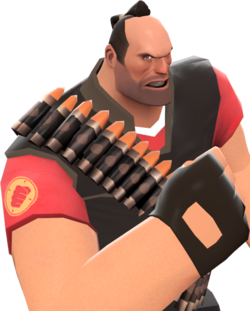Difference between revisions of "Dread Knot"
Dogspajamas (talk | contribs) m (→Trivia: "Firepower" is one word, not two.) |
m |
||
| Line 15: | Line 15: | ||
}} | }} | ||
{{Quotation|'''The Heavy''' on fighting with honor|Come; we fight like men.|sound=Heavy_meleedare12.wav}} | {{Quotation|'''The Heavy''' on fighting with honor|Come; we fight like men.|sound=Heavy_meleedare12.wav}} | ||
| − | The '''Dread Knot''' is a [[Steam Workshop|community-created]] [[Promotional items|promotional]] [[Hats|headwear]] item for the [[Heavy]]. It | + | The '''Dread Knot''' is a [[Steam Workshop|community-created]] [[Promotional items|promotional]] [[Hats|headwear]] item for the [[Heavy]]. It is a {{w|chonmage}}, the traditional top-knotted hairstyle of {{w|Edo period|edo-period}} men and samurai in Japan and, in more modern times, {{w|sumo wrestlers}}. |
This item was awarded in [[Genuine]] quality to players who pre-purchased ''[[Total War: SHOGUN 2]]'' on Steam before March 15, 2011. | This item was awarded in [[Genuine]] quality to players who pre-purchased ''[[Total War: SHOGUN 2]]'' on Steam before March 15, 2011. | ||
Revision as of 04:53, 28 March 2012
| “ | Come; we fight like men.
Click to listen
— The Heavy on fighting with honor
|
” |
The Dread Knot is a community-created promotional headwear item for the Heavy. It is a Template:W, the traditional top-knotted hairstyle of Template:W men and samurai in Japan and, in more modern times, Template:W.
This item was awarded in Genuine quality to players who pre-purchased Total War: SHOGUN 2 on Steam before March 15, 2011.
Update history
March 10, 2011 Patch (Shogun Pack)
- The Dread Knot was added to the game.
- Fixed the new Shogun hats not being grayed out when paint is being used.
- This hat is now able to be traded along with all Shogun Pack items.
Trivia
- The name is a reference to the "Template:W", a type of 20th century battleship with tremendous firepower. The word itself literally means "fear nothing".
- Chonmage hairstyles were popular in feudal Japan as a convenient way to keep one's hat or helmet on. They remained popular until the early 20th century.
Gallery
| |||||||||||
| ||||||||||||||||||||||||||||||||||||||||||||||||||||||||||||||||||||||||||||||||||||||||||||||||||||||||||||||||||||||||||||||||||||||||||||||||||||||||||||||||||||||||||||||||||||||||||||||||||||||||||||||||||||||||||||||||||||||||||||||||||||||||||||||||||||||||||||||||||||||||||||||||||||||||||||||||||||
| |||||||||||||||||||||||||||||||||||||||||||


